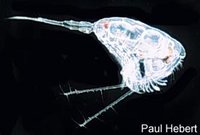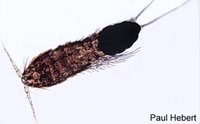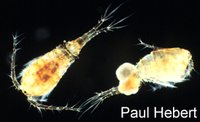
| Palaeos |  |
Maxillopoda |
| Arthropoda | Copepoda |
| Page Back: Branchiura | Unit Up: Arthropoda | Unit Home | Clade Up: Eucrustacea | Page Next: Ostracoda |
| Unit Back: Branchiopoda | Clade Down: None | Dendrogram | References | Unit Next: Ostracoda |
|
Abbreviated Dendrogram
CRUSTACEA |--Phosphatocopida `--+--Branchiopoda |?--Xenocarida `--+==MAXILLOPODA | |--Thecostraca | |--Branchiura | `--Copepoda |--Ostracoda `--Malacostraca |
Contents
|
Taxa on This Page
This content on this page copied verbatum from Encyclopedia of Earth - Crustacea under Creative Commons Attribution Share-Alike license. It is intended at some point to add additional material on evolution, paleontology, etc MAK120517
 (Source: Biodiversity Institute of Ontario) |
The Copepoda is one of the largest groups of crustaceans. Approximately 12,000 species have been described, but this may be as little as 15% of the total number of species! Copepods are abundant in both marine and freshwater systems, but are much more diverse in marine environments.
 (Source: Biodiversity Institute of Ontario) |
Copepods have long first antennae and a single, median eye located on the anterior (front) portion of the head. They have two pairs of antennae and biramous feeding appendages. The first pair of antennae is often sexually dimorphic and bears chemoreceptors and mechanoreceptors. Antennules (first antennae) are used for locomotion, feeding and reproduction. Each segment of the thorax bears a pair of swimming appendages. The last abdominal segment has two caudal rami which have an unknown function, but are useful in taxonomy for distinguishing between groups of copepods. The largest copepods attain lengths of 3 mm, although most species are less than 1.0 mm.
 (Source: Biodiversity Institute of Ontario) |
All species of freshwater copepods reproduce sexually. After mating, the eggs undergo brief embryonic development before they are released into the water as nauplius larvae. The nauplius undergoes five moults before it transforms into a copepodite stage that more closely resembles the adult. If unfavourable environmental conditions, such as declines in temperature, oxygen or food availability, occur, the copepodite larvae of some freshwater species can enter a diapause stage until conditions improve.
 (Source: Biodiversity Institute of Ontario) |
Copepods occur in oceans, estuaries, lakes, ponds, groundwater, wet moss and even in pools of water that collect in the leaves of terrestrial plants. They are an important food source for larval fish and other invertebrates in aquatic systems. Most are omnivores, filtering algae and bacteria from the water as well as preying upon other small invertebrates. As a result they are an important link between the primary producers (algae) and the larger secondary consumers (fish larvae). Almost half of all known copepod species are either parasitic or commensal with other organisms. Parasitic copepods often cling to the outside of their host, but others are more intrusive, having invaded their gills, nostrils, or mouths of their hosts. Copepods are the intermediate hosts of other parasites, such as the nematode Dracunculus medinensis and the tapeworm Diphyllobothrium latum which can be passed on to humans.
Although copepods are extremely small and generally harmless, some species can be dangerous. Copepods carry many parasites and diseases that can cause death in humans - and all you have to do is eat or drink the copepod.
| Page Back: Branchiura | Unit Home | Page Top | Page Next: Ostracoda |
From "Crustacea", Encyclopedia of Earth. Eds. Cutler J. Cleveland (Washington, D.C.: Environmental Information Coalition, National Council for Science and the Environment) 100219; revised 110529; Creative Commons Attribution Share-Alike